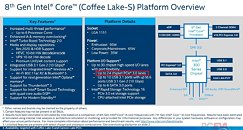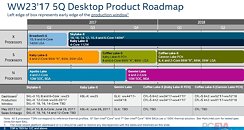Monday, August 7th 2017

Intel "Coffee Lake" Platform Detailed - 24 PCIe Lanes from the Chipset
Intel seems to be addressing key platform limitations with its 8th generation Core "Coffee Lake" mainstream desktop platform. The first Core i7 and Core i5 "Coffee Lake" processors will launch later this year, alongside motherboards based on the Intel Z370 Express chipset. Leaked company slides detailing this chipset make an interesting revelation, that the chipset itself puts out 24 PCI-Express gen 3.0 lanes, that's not counting the 16 lanes the processor puts out for up to two PEG (PCI-Express Graphics) slots.
The PCI-Express lane budget of "Coffee Lake" platform is a huge step-up from the 8-12 general purpose lanes put out by previous-generation Intel chipsets, and will enable motherboard designers to cram their products with multiple M.2 and U.2 storage options, besides bandwidth-heavy onboard devices such as additional USB 3.1 and Thunderbolt controllers. The chipset itself integrates a multitude of bandwidth-hungry connectivity options. It integrates a 10-port USB 3.1 controller, from which six ports run at 10 Gbps, and four at 5 Gbps.Other onboard controllers includes a SATA AHCI/RAID controller with six SATA 6 Gbps ports. The platform also introduces PCIe storage options (either an M.2 slot or a U.2 port), which is wired directly to the processor. This is drawing inspiration from AMD AM4 platform, in which an M.2/U.2 option is wired directly to the SoC, besides two SATA 6 Gbps ports. The chipset also integrates a WLAN interface with 802.11ac and Bluetooth 5.0, though we think only the controller logic is integrated, and not the PHY itself (which needs to be isolated for signal integrity).
Intel is also making the biggest change to onboard audio standards since the 15-year old Azalia (HD Audio) specification. The new Intel SmartSound Technology sees the integration of a "quad-core" DSP directly into the chipset, with a reduced-function CODEC sitting elsewhere on the motherboard, probably wired using I2S instead of PCIe (as in the case of Azalia). This could still very much be a software-accelerated technology, where the CPU does the heavy lifting with DA/AD conversion.
According to leaked roadmap slides, Intel will launch its first 8th generation Core "Coffee Lake" processors along with motherboards based on the Z370 chipset within Q3-2017. Mainstream and value variants of this chipset will launch only in 2018.
Sources:
VideoCardz, PCEVA Forums
The PCI-Express lane budget of "Coffee Lake" platform is a huge step-up from the 8-12 general purpose lanes put out by previous-generation Intel chipsets, and will enable motherboard designers to cram their products with multiple M.2 and U.2 storage options, besides bandwidth-heavy onboard devices such as additional USB 3.1 and Thunderbolt controllers. The chipset itself integrates a multitude of bandwidth-hungry connectivity options. It integrates a 10-port USB 3.1 controller, from which six ports run at 10 Gbps, and four at 5 Gbps.Other onboard controllers includes a SATA AHCI/RAID controller with six SATA 6 Gbps ports. The platform also introduces PCIe storage options (either an M.2 slot or a U.2 port), which is wired directly to the processor. This is drawing inspiration from AMD AM4 platform, in which an M.2/U.2 option is wired directly to the SoC, besides two SATA 6 Gbps ports. The chipset also integrates a WLAN interface with 802.11ac and Bluetooth 5.0, though we think only the controller logic is integrated, and not the PHY itself (which needs to be isolated for signal integrity).
Intel is also making the biggest change to onboard audio standards since the 15-year old Azalia (HD Audio) specification. The new Intel SmartSound Technology sees the integration of a "quad-core" DSP directly into the chipset, with a reduced-function CODEC sitting elsewhere on the motherboard, probably wired using I2S instead of PCIe (as in the case of Azalia). This could still very much be a software-accelerated technology, where the CPU does the heavy lifting with DA/AD conversion.
According to leaked roadmap slides, Intel will launch its first 8th generation Core "Coffee Lake" processors along with motherboards based on the Z370 chipset within Q3-2017. Mainstream and value variants of this chipset will launch only in 2018.




119 Comments on Intel "Coffee Lake" Platform Detailed - 24 PCIe Lanes from the Chipset
Am interested in the sound thingie. I wonder what it'll be like...
Also, the Z370 appears to just a rebadge of the Z270 chipset, so there aren't really any news in terms of features. Please see ark.intel.com/products/98089/Intel-Z270-Chipset which clearly shows support for up to 24 PCIe lanes.
I'm also curious as to where the idea of extra PCIe lanes from the CPU is coming. All the slides state is that the Coffe Lake platform will support CPU-attached Intel PCIe storage, which most likely means you have to go down to x8 for graphics. The fact that it says Intel PCIe storage also suggests that it'll only work with Intel SSDs.
One more thing, the audio is apparently via MIPI if you look at the slide with the chipset diagram, not I2S.
There are some other features and integrated controller IO/connectivity that Z370 brings though which weren't available on Z270. Those could be interesting for sure
I mostly play Indie games and HoTS these days so I don't really need a 6-core CPU. It's nice to have a proper 6-core mainstream CPUs from Intel, unlike the Ryzen ones, but most people don't need them.
Also, how are the Ryzen 6-cores not proper processors?
At the same time, I'm wondering where would manufacturers physically place those many M2 ports we are all waiting for. My motherboard is full ATX and can only accommodate 3. Perhaps with some redesign there could be 4. But that's still a far cry from the number of SATA ports we are used to.
Z270 offers 24 lanes and Z170 offers 20 lanes.
Multiple M.2, U.2 and USB 3.1 Gen 2 ports ... well, if you try to use all of them simultaneously, you will be bottlenecked by the 4-lane interconnect between the chipset and CPU. Honestly I don't understand why Intel can't just add 4 extra lanes into the CPU making it 20 instead of 16. Then users will be able to have a full 16x lane for graphics and the remaining 4 for a CPU attached storage. Surely a 20-lane mainstream CPU will not affect the sales of those 28 - 40 lanes HEDT parts.
Maybe in conjunction with case makers, a suitable area could be left with a hole (like the CPU holes we have seen appear in the last few years) to make using them easier?
1 on the rear for e.g. boot drive and 3 or 4 on the front and then maybe a couple on a riser (like Asus do) would give a good number.Isn't Dolby calling their system "TrueAudio" and MasterAudio is the DTS one?
I want to see DTS-X and Atmos on-board, 15 channels. :) (4 subs)
That would save buying a separate sound processor.
This is a die shot of the i7-7700K.
And this is a die shot of an i7-6950X
Although they're not perfect comparisons, you can see that the I/O takes up a lot more space on the latter and part of this is the PCIe root complex. So there are some trade-offs to be done when it comes to die space used up by whatever part you want to stick inside a chip.
Likewise AMD compromised on Ryzen, although we get 20 usable lanes from the CPU, the chipset is instead crippled by only offering PCIe 2.0 lanes. The performance difference for NVMe between Ryzen and Intel (at least in my case using an Plextor M8PeG drive) is actually in favour of Intel in most tests, surprisingly and this was using a Z170 board.
Regardless, it would be nice to see Intel adding another 4-8 PCIe lanes to the CPU that could be used for storage and say 10Gbps Ethernet.
Now stop spreading hate because of a hardware product, geez.
Did I tell you about the time Intel allowed non Z OC & then shut it down after the sales of h87/97/170 were eating into their Zxx big fat profit margins, or the unofficial hiatus on G4560?
It's a shame that more people put up with this, not you but many others :shadedshu:
If you want to have people not be stupid, you should start with your own comments.